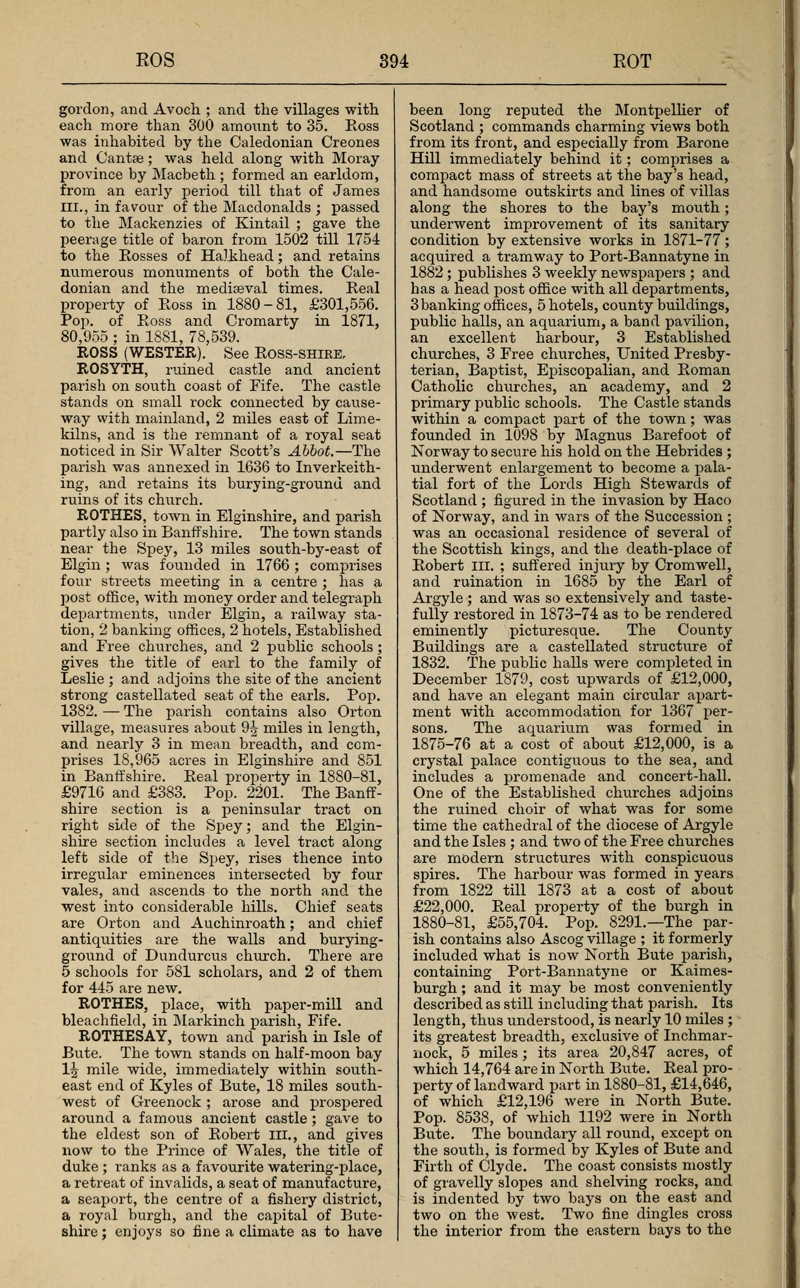ROSS (WESTER).
ROSYTH, ruined castle and ancient parish on south coast of Fife. The castle stands on small rock connected by cause-way with mainland, 2 miles east of Limekilns, and is the remnant of a royal seat noticed in Sir Walter Scott's Abbot. The parish was annexed in 1636 to Inverkeithing, and retains its burying-grounu and ruins of its church.
ROTHES, town in Elginshire, and parish partly also in Banff shire. The town stands near the Spey, 13 miles south-by-east of Elgin ; was founded in 1766 ; comprises four streets meeting in a centre ; has a post office, with money order and telegraph departments, under Elgin, a railway station, 2 banking offices, 2 hotels, Established and Free churches, and 2 public schools ; gives the title of earl to the family of Leslie ; and adjoins the site of the ancient strong castellated seat of the earls. Pop. 1382. The parish contains also Orton village, measures about 9 miles in length, and nearly 3 in mean breadth, and com-prises 18,965 acres in Elginshire and 851 in Banffshire. Real property in 1880-81, 9716 and 383. Pop. 2201. The Banffshire section is a peninsular tract on right side of the Spey; and the Elginshire section includes a level tract along left side of the Spey, rises thence into irregular eminences intersected by four vales, and ascends to the north and the west into considerable hills. Chief seats are Orton and Auchinroath ; and chief antiquities are the walls and burying-ground of Dundurcus church. There are 5 schools for 581 scholars, and 2 of them for 445 are new.
ROTHES, place, with paper-mill and bleachfield, in Markinch parish, Fife.
ROTHESAY, town and parish in Isle of Bute. The town stands on half-moon bay 1 mile wide, immediately within south-east end of Kyles of Bute, 18 miles south-west of Greenock ; arose and prospered around a famous ancient castle ; gave to the eldest son of Robert in., and gives now to the Prince of Wales, the title of duke ; ranks as a favourite watering-place, a retreat of invalids, a seat of manufacture, a seaport, the centre of a fishery district, a royal burgh, and the capital of Buteshire ; enjoys so fine a climate as to have been long reputed the Montpellier of Scotland ; commands charming views both from its front, and especially from Barone Hill immediately behind it ; comprises a compact mass of streets at the bay's head, and handsome outskirts and lines of villas along the shores to the bay's mouth ; underwent improvement of its sanitary-condition by extensive works in 1871-77 ; acquired a tramway to Port-Bannatyne in 1882 ; publishes 3 weekly newspapers ; and has a head post office with all departments, 3 banking offices, 5 hotels, county buildings, public halls, an aquarium, a band pavilion, an excellent harbour, 3 Established churches, 3 Free churches, United Presbyterian, Baptist, Episcopalian, and Roman Catholic churches, an academy, and 2 primary public schools. The Castle stands within a compact part of the town ; was founded in 1098 by Magnus Barefoot of Norway to secure his hold on the Hebrides ; underwent enlargement to become a palatial fort of the Lords High Stewards of Scotland ; figured in the invasion by Haco of Norway, and in wars of the Succession ; was an occasional residence of several of the Scottish kings, and the death-place of Robert in. ; suffered injury by Cromwell, and ruination in 1685 by the Earl of Argyle ; and was so extensively and taste-fully restored in 1873-74 as to be rendered eminently picturesque. The County Buildings are a castellated structure of 1832. The public halls were completed in December 1879, cost upwards of 12,000, and have an elegant main circular apartment with accommodation for 1367 per-sons. The aquai'ium was formed in 1875-76 at a cost of about 12,000, is a crystal palace contiguous to the sea, and includes a promenade and concert-hall. One of the Established churches adjoins the ruined choir of what was for some time the cathedral of the diocese of Argyle and the Isles ; and two of the Free churches are modern structures with conspicuous spires. The harbour was formed in years from 1822 till 1873 at a cost of about 22,000. Real property of the burgh in 1880-81, 55,704. Pop. 8291. The parish contains also Ascog village ; it formerly included what is now North Bute parish, containing Port-Bannatyne or Kaimesburgh ; and it may be most conveniently described as still including that parish. Its length, thus understood, is nearly 10 miles ; its greatest breadth, exclusive of Inchmarnock, 5 miles ; its area 20,847 acres, of which 14,764 are in North Bute. Real property of landward part in 1880-81, 14,646, of which 12,196 were in North Bute. Pop. 8538, of which 1192 were in North Bute. The boundary all round, except on the south, is formed by Kyles of Bute and Firth of Clyde. The coast consists mostly of gravelly slopes and shelving rocks, and is indented by two bays on the east and two on the west. Two fine dingles cross the interior from the eastern bays to the western ones ; and rising-grounds and hills, with pleasing diversity of surface, fill nearly all the rest of the interior. Chief residences are handsome villas at and near Ascog ; and chief antiquities are a Caledonian stone circle, numerous standing-stones, tumuli, and hill-forts, and Kaimes and Kilmorie castles. Established and Free churches are in North Bute. There are 12 schools for 1930 scholars ; 2 of them for 516 are new, and 2 for 263 are outside of Rothesay burgh.

